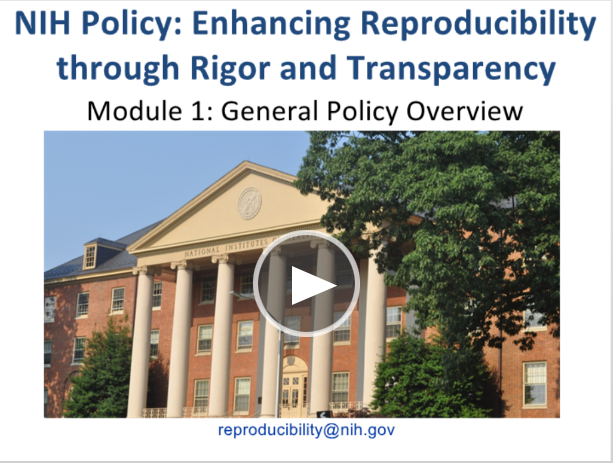Resources and training on many aspects of rigor and reproducibility, including sex as a biological variable, research methods, reviewer guidance and more.
Training
Get an overview of NIH's policy, specific information on key aspects of enhancing data reproducibility, and information on incorporating sex to strengthen experimental design.
General Policy Overview
Describes the issues of rigor and transparency and why NIH developed the policy, summarizes updates to grant application instructions and review language, and identifies resources available to meet staff needs.

Module 1: General Policy Overview
Beginning with applications due on January 25, 2019 the application instructions and review criteria will be clarified to replace the term “scientific premise” with the term "rigor of the prior research". Please note that this video uses the term “scientific premise,” which should now be understood as “rigor of the prior research.”
Video Transcript (DOCX, 45 KB)
NIGMS Clearinghouse for Training Modules to Enhance Data Reproducibility
Focus on integral aspects of rigor and reproducibility such as lack of transparent, blinding and randomization, biological and technical replicates and exclusion criteria


Pragmatic and Group-Randomized Trials in Public Health and Medicine Online Course
A 7-part online course developed by the NIH Office of Disease Prevention to help researchers design and analyze group-randomized trials (GRTs). It includes video presentations, slide sets, suggested reading materials, and guided activities.
Reviewer Guidance
Explore information NIH provides to scientific peer reviewers to help them evaluate rigor and transparency, including sex as a biological variable.
- SABV Decision Tree: Reviewer Guidance to Evaluate Sex as a Biological Variable (SABV) (PDF, 228 KB)
Helps determine how to acknowledge evaluating sex as a biological variable depending on study design (posted 07/20/2016)
- Reviewer Guidance on Rigor and Transparency (PDF, 200 KB)
Provides information on the four areas of the current rigor and transparency initiative for research project grants and mentored career development applications (compiled by NIH OER, 03/21/2016)

